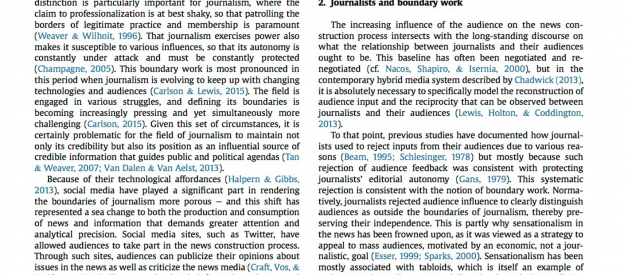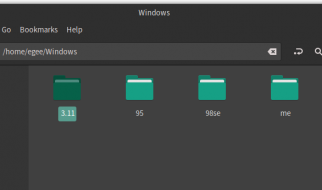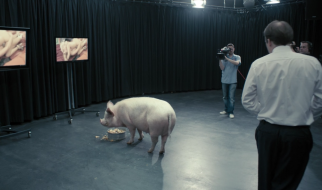?If everyone is a journalist, then no one is.? (Biggins, 2016, para. 3)
The role of a gatekeeper within journalism is of extreme importance in today?s media environment. Gatekeepers ultimately craft and conduct what is being published to the masses, therefore they determine what is to become the public?s social reality, and their view of the world (Shoemaker & Vos, 2009).
In recent years, there has been blurred lines between establishing who the media audiences are and who the journalists are in today?s society. Due to social media jumping the gates, and with the wide range of accessibility, the differences between public opinions and what is journalistic news is made indistinct.
With today?s fast-paced and competitive media environment, there has been a significant rise of these social media channels, creating outlets where anyone and everyone can be a journalist. Therefore, why do we need gatekeeper journalists anymore? The public need reliable, intelligent and relevant sources which they can go to for news, thus creating a push to try and deregulate clickbait and fake news within the media.
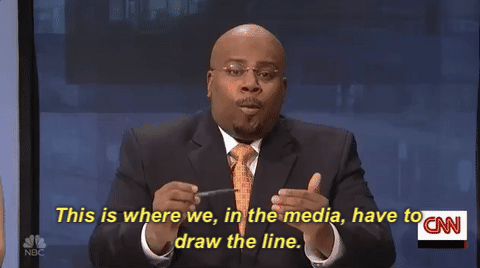 http://gph.is/2fckPnx
http://gph.is/2fckPnx
WHY IS THERE A NEED FOR GATEKEEPING JOURNALISM, WHEN ANYONE CAN BE A JOURNALIST?
Gatekeeping as a theory, is the news selection and extraction of news, which then gets passed through a series of gates (the journalists), and gets transformed and ends up in the news (Groshek & Tandoc, 2016). For an example, a journalist may decide to cover a story on New Zealand earthquakes, but will only extract parts of the news that are relevant and credible to be processed and supplied to the public, and then this becomes the news. The shift in society, through social media sites has seen this gatekeeping nonessential for journalism, as these sites jump the gates of traditional journalism, and the audience have the ultimate control over what they read, see or hear in these media echo chambers.
Groshek and Tandoc (2016) explains this within their article:
 http://ac.els-cdn.com.ezproxy.aut.ac.nz/S0747563216306471/1-s2.0-S0747563216306471-main.pdf?_tid=f0f693a4-38ff-11e7-b1bc-00000aacb361&acdnat=1494805937_03d3e4928975eed2788b05983c86dd55
http://ac.els-cdn.com.ezproxy.aut.ac.nz/S0747563216306471/1-s2.0-S0747563216306471-main.pdf?_tid=f0f693a4-38ff-11e7-b1bc-00000aacb361&acdnat=1494805937_03d3e4928975eed2788b05983c86dd55
There is need for gatekeeping journalists, especially due to the high consumption rates of clickbait, fake news and non-journalistic social media pages. This is because professional journalists need to assert control over news construction, as there needs to be a regulated system which audiences can access for educational and topical news (Groshek & Tandoc, 2016).
This all comes down to the public?s need for credibility. The audience needs to know what they are reading is truthful and honest, and as the conventional role of a journalist is to serve the public and maintain ethical conduct, this is where gatekeeping is still significant in our diverse media environment.
Heinonenn (2011), expressed that there is a need to safeguard these journalist?s professions and statuses among the media brand. This attributes to journalist?s protecting their work and autonomy from pressure of the audience (Groeshek & Tandoc, 2016).
The issue with credibility and professionalism within journalism, is that majority of journalists need to be able to uphold these standards, to try to differentiate them from the overcrowded fake news and clickbait articles which take up a significant portion in our media environment.
Audiences have become too used to this fast-paced and competitive environment of breaking news and sometimes lack understanding, that what is published into the media is not always reliable and honest. This can trap audiences in a social media environment, for example Facebook, which currently circulates clickbait articles. If the audience is not educated enough on fact from fiction, then they only believe these messages they are receiving in this public sphere. Therefore, we need gatekeepers to help dissect this, and bring out the truth in the news, and create an honest public sphere, which can control professional standards.
WHO ARE THE AUDIENCES, AND WHO ARE THE JOURNALIST?S?
The increasing audience participation with news construction, has created reciprocal journalism. This allows for audiences to create preferences of news content, and this contributes to the ever-changing power dynamics between the public and journalists (Groshek & Tandoc, 2016). This shift has seen national news organisations such as Stuff.co.nz, accommodating to the audience feedback, by using polls and a comments section for the public to react to their articles.
Are Jono and Ben ripping us off when they stage their jokes?
OPINION: We now know that Jono Pryor’s on-air ‘meltdown’ on his radio show was just a stunt. A stunt just like the time?
www.stuff.co.nz

This creates a public sphere where the audience can have a space to express what they believe is right, although this is not always the best look on journalists, as their hard-work gets manipulated and dejected.
Although the public need to remember that journalists are inhabitants of their own society, which objects them to outside and inside burdens and pressures, which they have to maintain (Hellmueller & Mellado, 2015). These pressures are usually proposed upon them by higher influences within their media organisations and the audiences who participate within these public spheres. Journalism becomes a structure of public communication, by the journalists and audiences becoming analogous (Steensen & Ahva, 2014), this is increasingly common through social media outlets.
People are becoming increasingly aware of this media environment through different platforms. An example of this is Talk, which is a play about the need for gatekeepers in journalism due to the rise of social media outlets. This was recently shown at the Sydney Opera House. Director Jonathan Biggins exclaimed that, ?there is no sustainable business model for serious journalism available through the internet. And I?ll make a brave call: there never will be.? (Biggins, 2016, para. 6). Social media sites like Twitter allows audience members to outpace traditional business models for journalism, as it breaks information and live photographs from events, although these outlets give no substance as you are only allowed a maximum of 160 characters in a tweet. Biggins (2016) drew on this, and expressed, ?The media today has collective ADHD; by constantly skimming the surface we rarely find out what?s happening underneath until it?s too late.? (para. 3).
There is now a need, more than ever before, to provide gatekeeping journalists with a safe environment, where they do not need to rely on audience feedback. Gatekeepers need a media environment which will differentiate the relationship between journalists and the public, and will provide news-worthy, deep and honest journalism.
THE ERA OF CLICKS AND FAKE NEWS:
Clickbait takes up majority of the articles on social media, which target particular audiences to get more clicks on their page or more ?likes?. Clickbait is essentially a style technique used to lure and induce curiosity so that the audience click on the headline and then read on from there (Blom & Hansen, 2015). The problem with these online headlines, is that audiences can perceive them as relevant and reliable news sources when they are most likely not, for example Buzzfeed or theedge.co.nz. If an audience is not critical enough of these sources, and they shift their attention towards these online social atmospheres, it diminishes the need for good journalism, as these could be the same audiences that believe anyone who writes an article or an opinion piece is immediately a journalist.
 https://twitter.com/rsingel
https://twitter.com/rsingel https://twitter.com/rsingel
https://twitter.com/rsingel
Audiences rely on these sources with interesting headlines, due to this fast-paced media environment, they have a short attention span on what is credible. The audience then shift their attention to rewarding bloggers, twitter accounts and unreliable news as it is more interesting, and gains clicks.
Blom and Hansen (2015) discovered that there was a strong inclination in tabloid and commercial media. BuzzFeed used ?forward referring headlines on news websites compared to non-commercial and non-tabloid media,? (p.98). BuzzFeed was created within the internet era, ?therefore did not have to adapt to an online social environment, thus their behaviours are fundamentally different to media legacy journalists or organisations which has struggled within this shift.? (Groshek & Tandoc, 2016, p. 205).
 http://ac.els-cdn.com.ezproxy.aut.ac.nz/S0747563216306471/1-s2.0-S0747563216306471-main.pdf?_tid=f0f693a4-38ff-11e7-b1bc-00000aacb361&acdnat=1494805937_03d3e4928975eed2788b05983c86dd55 (p.205)
http://ac.els-cdn.com.ezproxy.aut.ac.nz/S0747563216306471/1-s2.0-S0747563216306471-main.pdf?_tid=f0f693a4-38ff-11e7-b1bc-00000aacb361&acdnat=1494805937_03d3e4928975eed2788b05983c86dd55 (p.205)
These mass media era based organisations rely around clicks to secure itself a place within this environment. This BuzzFeed page as shown below, has no news worthy content, although this is what is being exposed within online sources and if audiences are not critical with the information they are receiving, they then interpret these media clickbait articles as relevant and resourceful news.
 https://www.buzzfeed.com/bensmith/why-buzzfeed-doesnt-do-clickbait?utm_term=.wi92JE041#.tmjYo0b2Q
https://www.buzzfeed.com/bensmith/why-buzzfeed-doesnt-do-clickbait?utm_term=.wi92JE041#.tmjYo0b2Q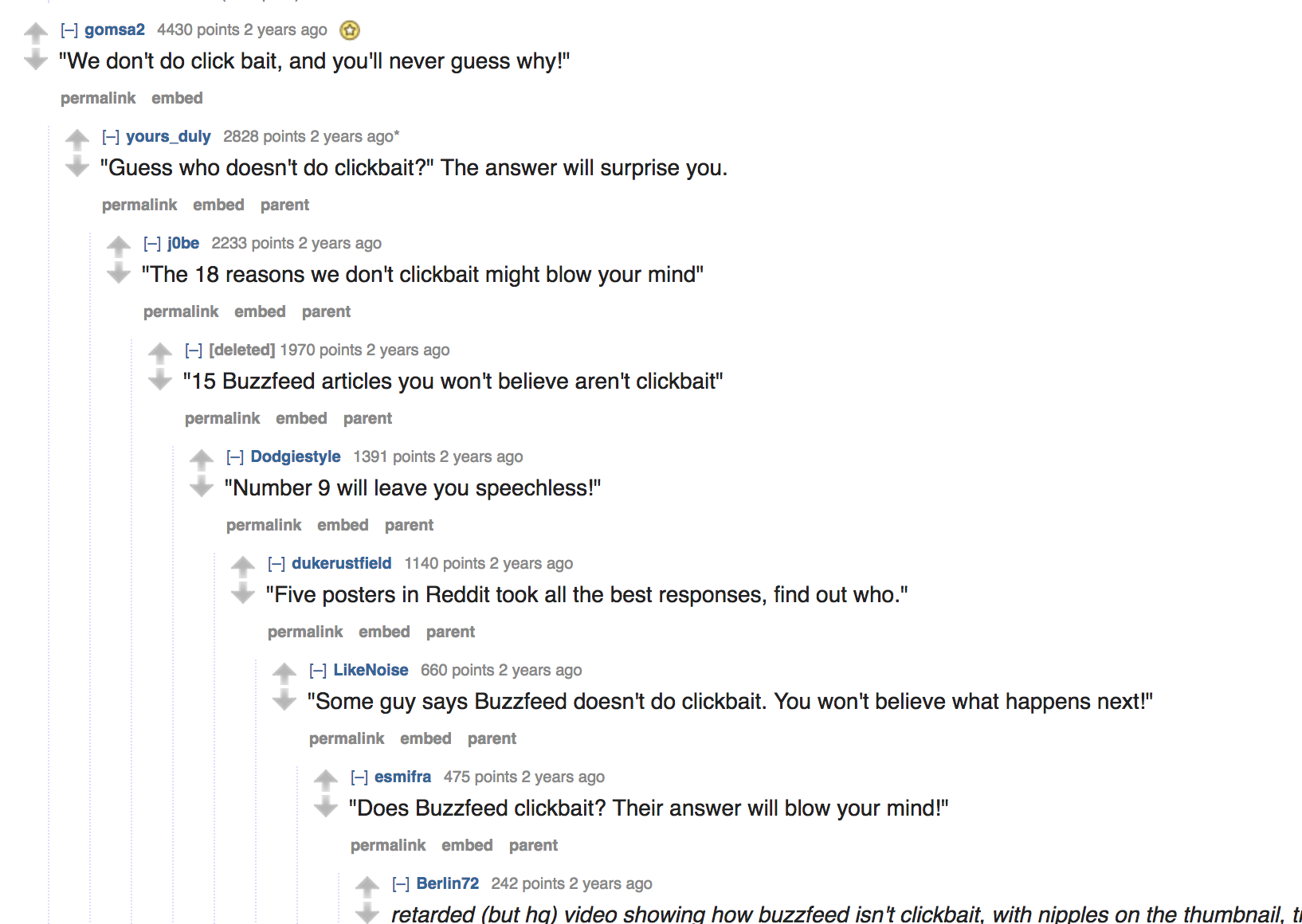 https://www.reddit.com/r/nottheonion/comments/2ll4cl/we_dont_do_clickbait_insists_buzzfeed/
https://www.reddit.com/r/nottheonion/comments/2ll4cl/we_dont_do_clickbait_insists_buzzfeed/
In a recent poll on Gallup, American citizen?s trust within the mass media has dropped to an all-time low of 32% confidence within the media. This corresponds with the need for journalists to be gatekeeping what gets placed within the news and what is truthful and reliable.
Americans’ Trust in Mass Media Sinks to New Low
Story Highlights 32% say they have “a great deal” or “a fair amount” of trust 14% of Republicans express trust, down?
www.gallup.com
Colin Peacock (2016) commented on the rise of clickbait within our media environment, as he explained that, ?the need to attract as big an audience as possible online, it encourages the media to give pride of place to some pretty cheap and nasty stuff sometimes, which may be fun, but it doesn?t make them look too flash, but it is more of a struggle to sustain the stuff of substance, which really does.?
Peacock (2016) referred to the fact that clickbait may well be the death of journalism and good journalism is becoming ?systematically obscured?. This is due to clickable stories which leaves an audience uneducated and uninformed. Fake news comes with clickbait, and it is present within this social media environment now more than ever. Facebook and similar social media page?s content, is relayed among users with no gatekeepers to help filter, fact-check and edit information which is spreading through these environments (Allcott & Gentzkow, 2017). A recent poll expressed that 62% of US Adults receive their news from social media, and with the fake news epidemic surrounding the 2016 American elections, Trump would have never been elected if it wasn?t for the fake articles which controlled the polls (Allcott & Gentzkow, 2017). Fake news has created a lot of social and economic costs, as it is problematic for consumers who believe everything they read, thus making it harder for them to interpret the world truthfully and this then has an effect on them voting in the election (Allcott & Gentzkow, 2017).
Allcott and Gentzkow?s findings are highlighted below, expressing the effect which these fake articles have created in our society.
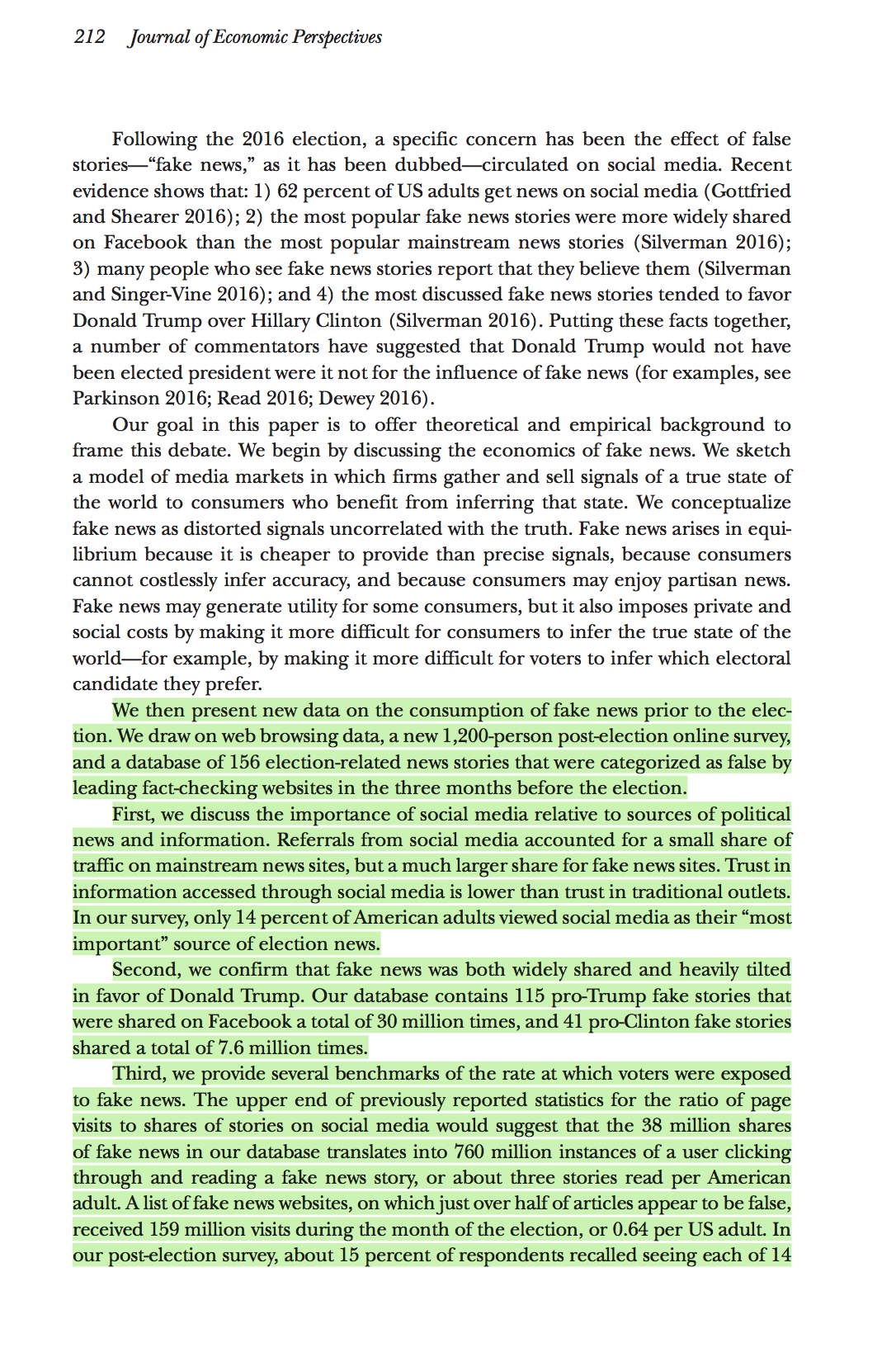
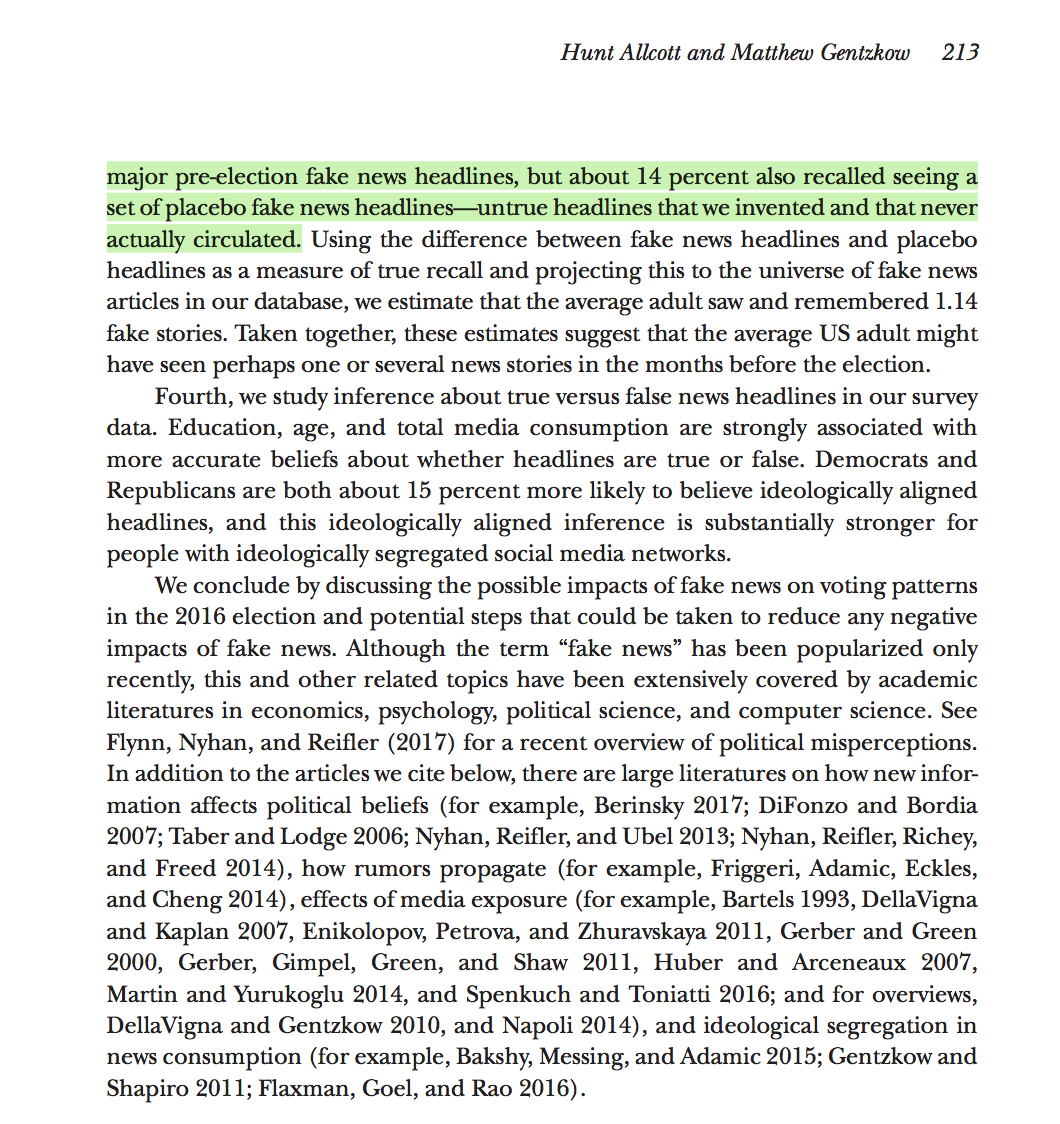
The rate of media consumption and the influence of fake news and clickbait articles indulges and influences the public, and if they are not critical enough with the websites, articles, facts and information being exposed to them, then they will try to make truth of the world from these fabricated news outlets. The public need reliable sources that they can gain news and information from. Without the need for gatekeepers, fake news is pumped into our media system and public sphere. Although, given the ever-changing media environment, the studies of the nature of journalism and the evolution surrounding it, it is unclear the future of journalism, due to the digital era (Steensen & Ahva, 2014), therefore we cannot conclude that these fake news and clickbait articles will lead journalism to expire.
TO CONCLUDE:
The need for gatekeeping in today?s media environment is stronger than ever, as there needs to be an honest public sphere which provides academic, cultural, historic, and ethical news, which has been filtered through by gatekeeping journalists. There is an overarching need to safeguard what is being published to the public throughout the mass media, to try deregulate click bait articles and fake news. Professional journalists need to assert control over news construction and protect their statuses among the public.
Audiences crave substance, knowledge and truth, therefore the role of a gatekeeper within today?s media environment, is critical to control and establish an honest public sphere.
References:
Allcott, H., & Gentzkow, M. (2017). Social media and fake news in the 2016 election. Journal of Economic Perspectives, 31(2), 211?236. doi:10.3386/w23089
Blom, J. N., & Hansen, K. R. (2015). Click bait: Forward-reference as lure in online news headlines. Journal of Pragmatics, 76, 87?100. doi:10.1016/j.pragma.2014.11.010
Groshek, J., & Tandoc, E. (2017). The affordance effect: Gatekeeping and (non)reciprocal journalism on Twitter. Computers in Human Behaviour, 66, 201?210. doi:10.1016/j.chb.2016.09.020
Heinonen, A. (2011). The Journalist?s Relationship with Users, in Participatory Journalism: Guarding Open Gates at Online Newspapers. Participatory Journalism. doi:10.1002/9781444340747.ch3
McConnell, G., & Kilgallon, S. (2017, May 11). Are Jono and Ben ripping us off when they stage their jokes? Retrieved from http://www.stuff.co.nz/entertainment/tv-radio/92428382/opinion-are-jono-and-ben-ripping-us-off-when-they-stage-their-jokes
Mellado, C., & Hellmueller, L. (2015). Professional roles and news construction: a media sociology conceptualization of journalists? role conception and performance. Communication & Society, 28(3), 1?11. doi:10.15581/003.28.3.1?11
Peacock, C. (Producer). (2016, September 11). Stuff of substance in a clickbait climate [Radio broadcast]. New Zealand: Mediawatch.
Reddit. (2014, November 7). We don?t do clickbait, insists BuzzFeed. Retrieved from https://www.reddit.com/r/nottheonion/comments/2ll4cl/we_dont_do_clickbait_insists_buzzfeed/
Shoemaker, P. J., & Vos, T. P. (2009). Gatekeeping theory. New York: Routledge, Taylor & Francis Group.
Smith, B. (2014, November 7). Why BuzzFeed Doesn?t Do Clickbait. Retrieved from https://www.buzzfeed.com/bensmith/why-buzzfeed-doesnt-do-clickbait?utm_term=.wi92JE041#.tmjYo0b2Q
Steensen, S., & Ahva, L. (2014). Theories of journalism in a digital age. Digital Journalism, 3(1), 1?18. doi:10.1080/21670811.2014.927984
Swift, A. (2016, September 14). Americans? Trust in Mass Media Sinks to New Low. Retrieved from http://www.gallup.com/poll/195542/americans-trust-mass-media-sinks-new-low.aspx
Sydney Theatre Company. (2016, September 6). Q&A: Jonathan Biggins on Talk. Retrieved from https://www.sydneytheatre.com.au/magazine/posts/2016/september/qa-jonathan-biggins
